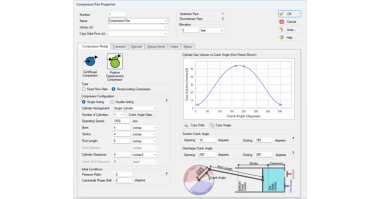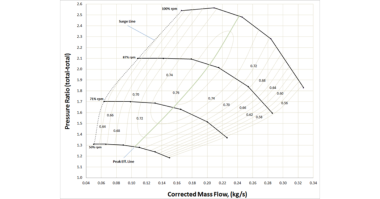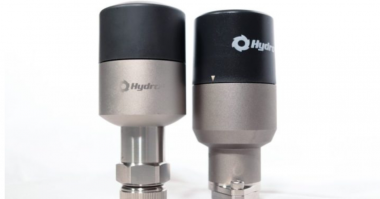Author: Robert X. Perez, Machinery Engineer
Introduction:
In my first installment, I discussed how ideal gases behave and how the ideal gas law can be used to convert gas volumes from one set of process conditions to another. Below, we will continue the discussion of gas flow conversions and explain how flow can be visualized as pressures and temperatures change.
Gas Flow Conversions
If the process was moving a gas at exactly the “standard” condition, then ACFM would equal SCFM. Unfortunately, this usually is not the case as process temperatures and pressure change from one point in the process to another. To move a gas, a positive pressure or vacuum must be created. When positive pressure is applied to a standard cubic foot of gas, it gets smaller and conversely when a vacuum is applied to a standard cubic foot of gas, it expands. The volume of gas after it is pressurized or rarefied is referred to as its “actual” volume.
Beware that some compressor manufacturers will use the term CFM for the flow of air out of the compressor discharge to the receiver or to the plant air mains. Others will use the acronym ACFM (Actual CFM) as the measure for air from their compressors.
Now we can begin calculating. Here is the equation to convert from SCFM to ACFM, assuming an ideal gas, i.e. z=1 (z, the compressibility factor, is defined latter in this article):

In Equation 2, Pactual is in psia and Tactual is in oR.
Here is the equation to convert from ACFM to SCFM assuming an ideal gas:

In Equation 3, Pactual is in psia and Tactual is in oR.
Here is the equation to convert from SCFM to ICFM assuming an ideal gas:

In Equation 4, Pinlet is in psia and Tinlet is in oR.
Example of how to convert from SCFM to ACFM
Let’s say you want to know what volume of gas 2500 scfm represents at 200 psig and 250 oF. First, make sure you convert gauge pressure into absolute pressure units, i.e. 200 psig = 214.7 psia and temperature into absolute units, i.e. 250 F =710 R. Now we can readily calculate ACFM using equation (2) and obtain a value of 233.1 acfm.

Visualizing Gas Flow
To better understand the relationship between these different flow terms, let’s study the simple compression system depicted in figure 2. Here we have a compressor taking suction from the atmosphere (standard conditions) and discharging the gas into a higher pressure system of 50 psig. Eventually, the gas flows across a control valve, causing the pressure to drop to 40 psig. If we follow the air flow through the compression system below, we can see how each of these flow terms apply.

Figure 2. Hypothetical compressor piping system
Let’s assume:
- We start with 1000 scfm at standard conditions at the point “A”
- Then we see a drop in pressure to -1.0 psig (13.7 psia) at the compressor suction at point “B”
- Then we see an increase in pressure at point C to 50 psig.
- Finally we see a drop in pressure to 10 psig at point B.
Table 1 below summarizes the change in volumetric flowrates at these conditions.
| Point | Note | Psia | Temp (F) | Cubic feet/minute |
| A | SCFM | 14.7 | 60 | 1000 |
| B | ICFM | 13.7 | 60 | 1073.0 |
| C | ACFM | 64.7 | 250 | 310.2 |
| D | ACFM | 54.7 | 245 | 364.3 |
At the entrance (A) of the inlet piping, let’s define the gas volume is 100%. Because there is some pressure drop in the suction piping, the inlet volume (ICFM) at B will be slightly greater (107.3%) than the volume at A. After the gas is compressed, the volumetric flow at the compressor discharge, designated as actual cubic feet per minute (ACFM) will be less (31.02%) than the volumetric flow at A. Finally, after the control valve, the ACFM increases slightly (36.17%) compared to the flow at C because the pressure has been reduced.
About the Author:
 Robert X. Perez has over 30 years of rotating equipment experience in the petrochemical industry. He earned a BSME degree from Texas A&M University (College Station), a MSME degree from the University of Texas at Austin, and is a licensed professional engineer in the state of Texas. Mr. Perez served as an adjunct professor at Texas A&M University-Corpus Christi, where he developed and taught the Engineering Technology Rotating Equipment course.
Robert X. Perez has over 30 years of rotating equipment experience in the petrochemical industry. He earned a BSME degree from Texas A&M University (College Station), a MSME degree from the University of Texas at Austin, and is a licensed professional engineer in the state of Texas. Mr. Perez served as an adjunct professor at Texas A&M University-Corpus Christi, where he developed and taught the Engineering Technology Rotating Equipment course.
He authored four books and coauthored four books in the field of machinery reliability. Mr. Perez has also written numerous machinery reliability articles for numerous technical conferences and magazines.




